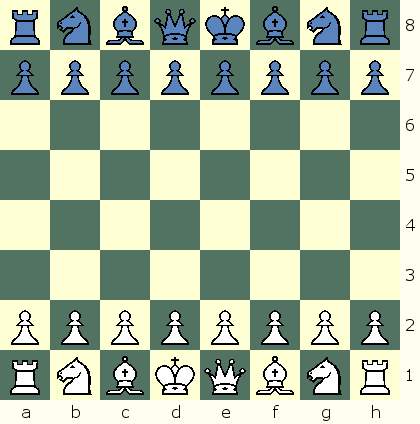Displacement Chess 2
-
The game in a nutshell
- The board is setup using either position #1 or #2. Either White's or Black's king and queen are interchanged.
- Castling rules are extended to allow a side to move the king from 1-3 spaces towards the rook, and the rook ending up adjacent to the king on the other side. This choice of castling positions allows the side to choose between immediate king safety or immediate offense of a centralized rook.
That's it! Clearly, this is the most logical step in chess's evolution involving very few changes. Even more so than Fischer Random because it preserves the same start squares for bishops, rooks and knights, and does not completely throw out opening theory.
Setup

|
Displacement Chess Start Board #2
Coordinates for white: Rooks on a1,h1 knights on b1,g1 bishops on c1, f1 queen on e1 king on d1 Coordinates for black: Rooks on a8,h8 knights on b8,g8 bishops on c8, f8 queen on d8 king on e8 |
Pieces
Same as in standard chess.
Rules
The rules are identical to rules of Chess except for board setup above and for castling. The same criteria for castling apply but instead of just two, there are 5 castling positions, The positions below are for board #1. The castling positions for board 2 are similar and can be deduced.
-
One Step K-Side Castling
White moves king from e1-f1 and rook from h1-e1
Black moves king from d8-c8 and rook from a8-d8 - One Step Q-side Castling
White moves king from e1-d1 and rook from a1-e1
Black moves king from d8-e8 and rook from h8-d8 -
Two Step K-Side Castling
White moves king from e1-g1 and rook from h1-f1
Black moves king from d8-b8 and rook from a8-c8 - Two Step Q-Side Castling
White moves king from e1-c1 and rook from a1-d1
Black moves king from d8-f8 and rook from h8-e8 -
Three Step Q-side Castling
White moves king from e1 to b1 and rook from a1-c1
Black moves king from d8-g1 and rook from h8-f8.
Notes
As mentioned in "Popular Chess Variants" by David Pritchard, a correspondence tournament of displacment chess was organized in 1935 by P.Keres.Keres finished second in this event that featured whites king and queen interchanged as in Board #2. Castling was the usual two step K or Q side variety.
Below is a game in that event won by H.Muller:

Position after move 22.Rxc3 Now comes Rxb3! Game taken from "Popular Chess Variants" by David Pritchard |
1. d4 d5 2. Nf3 Nf6 3. Nc3 e6 4. Bg5 c5 5.e3 Nc6 6. Bb5 cxd4 7.exd4 Be7 8.Qe2 Bd7 9. 0-0 0-0 10. Rad1 a6 11. Bd3 b5 12. a3 b4 13. axb4 Nxb4 14. Ne5 Rb8 15. Kg1 Qc7 16. b3 Be8 17. Qf3 Bb5! 18. Nxb5 axb5 19.Re3 Rxd3 20.Rdxd3 b4 21. c4? bxc3 22. Rxc3 Rxb3! see diagram 23.g4 Rxc3 24. Rxc3 Qd6 25. Bf4 Ne4 26. Ng6 fxg6 Â Â If now 27. Bxd6 Rxf3 Â 28. Rxf3 Nxd6 Â and the white d-pawn falls. { White Resigns } |
As noted above, Displacement Chess has been suggested and tried out before. It seems to have been forgotten despite it being less of a change than Fischer Random Chess.
The Castling Rules were adapted from an earlier form called free castling, and are also used in my large board games such as
Birds and Ninjas.
This game seems far more sensible than the remarkably destructive rules suggested by others to correct an alleged draw problem in chess. Re-starting opening theory, this game could ensure that chess opening theory remain fresh for another 200 years.
Of course preliminary opening theory is necessary to discover at least if the advantage to White is acceptable in this game. I believe it is probably much more balanced than some of the positions arising in Fischer Random, so this should not be a problem.
It was suggested by Kasparov to play from only a few start positions of Fischer Random. The two start configurations of this game could also be played alongide. This would certainly inject more novely into the first 20 moves of a GM chessgame.
-
Other games of interest:
- Stealth Ninja Chess
- Birds and Ninjas
 This 'user submitted' page is a collaboration between the posting user and the Chess Variant Pages. Registered contributors to the Chess Variant Pages have the ability to post their own works, subject to review and editing by the Chess Variant Pages Editorial Staff.
This 'user submitted' page is a collaboration between the posting user and the Chess Variant Pages. Registered contributors to the Chess Variant Pages have the ability to post their own works, subject to review and editing by the Chess Variant Pages Editorial Staff.
Author: Charles Daniel.
Last revised by H. G. Muller.
Web page created: 2008-08-01. Web page last updated: 2022-12-03
